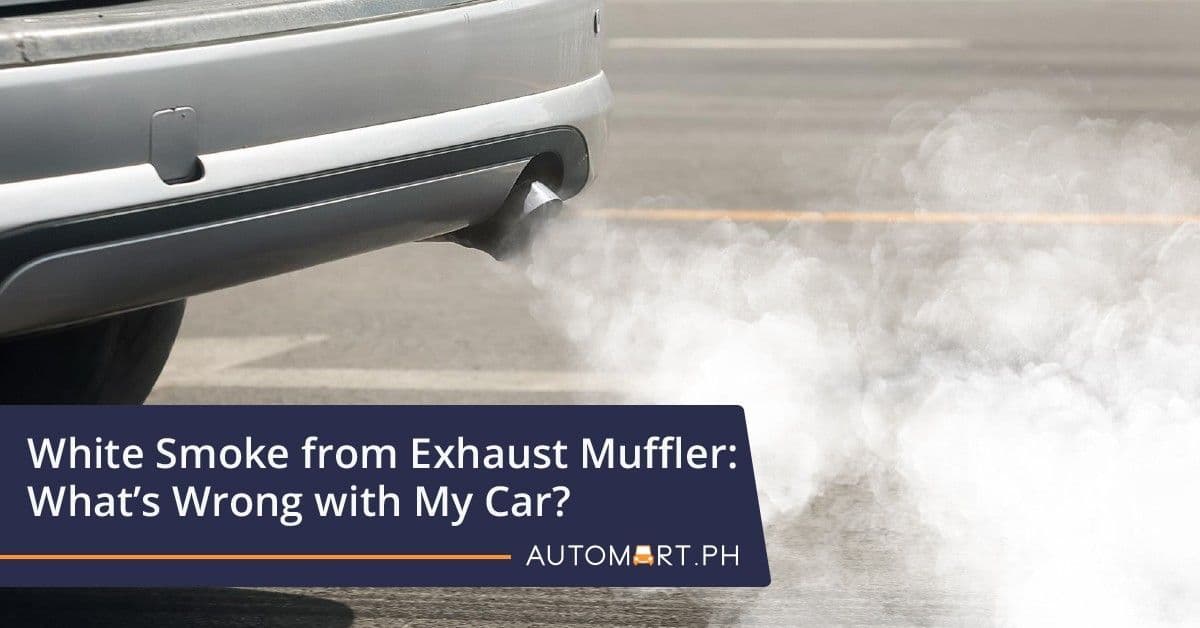
White Smoke from Exhaust Muffler: What’s Wrong with My Car?
Updated on December 18 2025
You are probably aware that the muffler, tailpipe, or the tambutso, in your car is responsible for emitting the byproducts of combusting air and fuel inside your engine. During cold starts in the morning, it is customary to see visible white smoke from the exhaust, and it has something to do with water condensation as the engine warms up.

However, thin and wispy white smoke during cold starts should go away once the engine reaches its ideal operating temperature. But if white smoke is constantly streaming from the muffler of a gasoline car, it could mean engine trouble. For diesel cars, trucks, and SUVs that consistently emit white smoke from the tailpipe, it could mean the diesel fuel is mixing with water or possibly a clogged fuel filter.
White Smoke in Gasoline Cars: What’s the Problem?
As mentioned earlier, it is typical for gasoline cars to emit white smoke during cold starts. This phenomenon is most prevalent in cold and frosty weather. We don’t have a winter season in the Philippines, but the colder months between November and January will allow you to observe this fact.
Under normal operating conditions, that white smoke should disappear or dissipate as the engine warms up. But if white smoke is still visible even if the engine is hot, it could signify an internal coolant leak.
White Smoke in Diesel Cars: What’s the Problem?
We all know diesel vehicles emit black smoke during hard acceleration. But what about white smoke? Unlike gasoline engines with spark plugs to ignite the air/fuel mixture, diesel engines use heat and pressure to ignite the air/fuel combo. So, unfortunately, a diesel engine blowing white smoke from the tailpipe means a lack of heat or incomplete combustion.

White smoke in diesel cars can mean a worn motor (loss of compression), a clogged fuel filter, a faulty injector pump, damaged fuel injectors, or water contamination in the diesel fuel. In addition, white diesel smoke is noticeable if the engine has a cracked cylinder head or warped engine block, pointing to an internal coolant leak.
What are the symptoms of an internal coolant leak?
Modern engines have coolant passages inside the engine block and cylinder head. The coolant absorbs heat as it circulates inside the motor. It then flows to the radiator to disperse heat, and the cycle repeats. The cooling system is a sealed system, and a noticeable loss of coolant could either mean an internal or external leak.

External coolant leaks are relatively easy to diagnose. But what happens if the coolant leaks inside the engine? It will mix with the air and fuel inside the combustion chamber and produce white smoke. The other symptoms of an internal coolant leak are:
A. Thick smoke from the exhaust, most especially during hard acceleration.
B. The presence of a sweet or unusual odor from the white smoke in the tailpipe.
C. Frothy, discolored, or contaminated engine oil. You can confirm this by checking the engine oil dipstick.
D. Persistent coolant loss and engine overheating.
How does coolant or water enter the combustion chamber?
There are three main reasons why your engine is burning coolant instead of only air and fuel.
1. The engine has a cracked or warped cylinder head.
2. The engine may have a broken or cracked head.
3. You may be dealing with a head gasket failure.
Any of the above may cause that billowy white smoke from the muffler. However, all of those problems will arise if you have overheating issues. Excessive heat can warp or destroy aluminum cylinder heads and engine blocks, allowing the coolant to penetrate inside the combustion chamber.

In addition, the head gasket seals the cylinder head from the cylinder block. If the head gasket is faulty, coolant may enter the combustion chamber and cause many problems like white exhaust smoke, a faulty catalytic converter, and possible engine failure in the long run.

Warping cylinder heads and head gaskets are more common in modern vehicles with lighter cast alloy or aluminum engine parts. On the contrary, older motors with cast iron heads are heavier, bulkier, and are more resistant to warping or cracking when the engine overheats. But modern engines with lightweight parts may be damaged easily by a single overheating incident, and that’s a fact.
How can I prevent internal coolant leaks?
The best way to prevent internal coolant leaks is to avoid overheating the engine. If your vehicle overheats, park the car immediately and pop open the hood to vent out the excess heat.

The reasons for an overheating engine include too little or no coolant, a faulty water pump, thermostat failure, a clogged up radiator, low oil levels, internal and external coolant leaks, a burned-out cooling fan, and a broken heater core, to name a few.
Conclusion
If your vehicle persistently blows thick, white smoke from the exhaust, bring it immediately to your trusted mechanic. The mechanic may need to take the engine apart to pinpoint the issue.

Meanwhile, you can avoid damaging the cylinder heads and gaskets if you prevent engine overheating. Always check the coolant level in the reservoir before taking a long trip. Remember that a slight loss of coolant is acceptable, but relentless coolant loss is not normal – it means the engine is burning coolant along with the air and fuel, leading to white smoke in the exhaust.